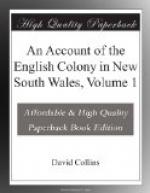In the exercise of this weapon they are very expert. I have seen them strike with certainty at the distance of seventy measured yards. They are thrown with great force, and where they are barbed are very formidable instruments. The wo-mer-ra, or throwing-stick, is always made use of on such occasions. This is a stick about three feet long, with a hook at one end (and a shell at the other, secured by gum), to receive which there is a small hole at the head of the spear. Both are held in the right hand. the fingers of which are placed, two above the throwing-stick, and two between it and the spear, at about the distance of two feet from the hook. After poising it for some time, and measuring with the eye the distance from the object to be thrown at, the spear is discharged, the throwing-stick remaining in the hand. Of these instruments there are two kinds; the one, named Wo-mer-ra, is armed with the shell of a clam, which they term Kah-dien, and which they use for the same purposes that we employ a knife. The other, which they name Wig-goon, has a hook, but no shell, and is rounded at the end. With this they dig the fern-root and yam out of the earth, and it is formed of heavy wood, while the wo-mer-ra is only part of a wattle split. They have several varieties of spears, every difference in them being distinguished by a name. Some are only pointed; others have one or more barbs, either shaped from the solid piece of wood of which the spear is made, or fastened on with gum; and some are armed with pieces of broken oyster-shell for four or five inches from the point, and secured by gum. All these barbed spears are dangerous, from the difficulty of extracting them. Of shields they have but two sorts. One, named E-lee-mong, is cut from the bark of the gum tree, and is not so capable of resisting the spear as the Ar-rah-gong, which is formed of solid wood, and hardened by fire. This shield is not so much in use as the e-lee-mong, as I imagine from its greater weight, and perhaps also from the superior difficulty they meet with in procuring it. Of clubs they use several sorts, some of which are of very large dimensions. They have one, the head of which is flat, with a sharp point in the centre. The flat part is painted with red and white stripes from the centre, and does not look unlike what they term it, Gnal-lung-ul-la, the name given by them to a mushroom. They have yet another instrument, which they call Ta-war-rang.




